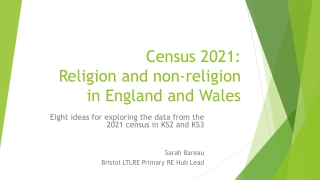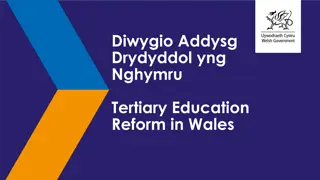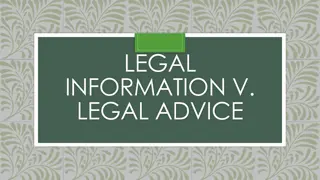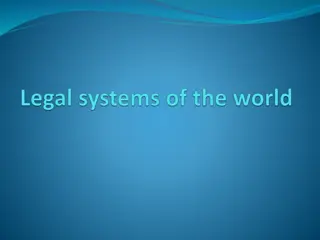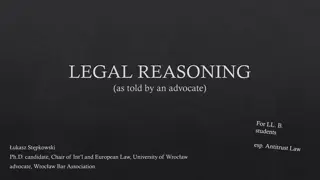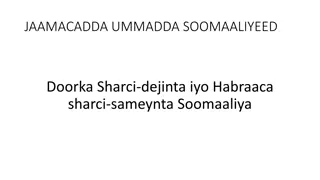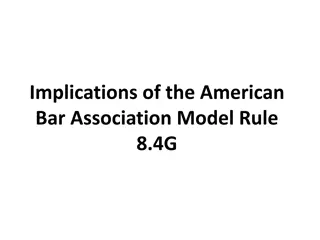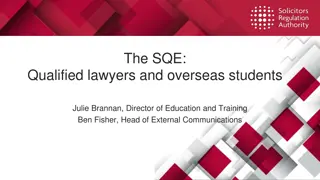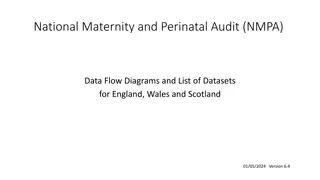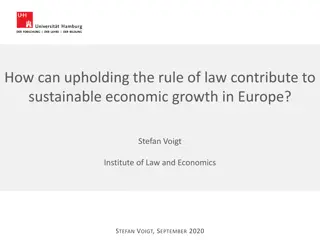Understanding the Rule of Law and Legal Systems in Wales and England
The content discusses the nature of law, the Welsh and English legal systems, and the Rule of Law doctrine. It includes observations from the 2019 AS Law Unit 1 examination, emphasizing the importance of adhering to rubrics and answering questions clearly. Candidates faced challenges with timing and question interpretation. Recommendations are given to strengthen understanding of the Rule of Law, including key concepts like Dicey's theories, separation of powers, and breaches of the rule of law. The need for clear case citations and relevance in responses is highlighted.
Download Presentation

Please find below an Image/Link to download the presentation.
The content on the website is provided AS IS for your information and personal use only. It may not be sold, licensed, or shared on other websites without obtaining consent from the author. Download presentation by click this link. If you encounter any issues during the download, it is possible that the publisher has removed the file from their server.
E N D
Presentation Transcript
AS Law Unit 1 The Nature of law and the Welsh and English Legal System
Recordior Sain / Audio Recording Mae'n ofynnol i'r cyflwynydd recordio'r sain yn y digwyddiad hwn. Dull rheoli yw hwn i sicrhau y gall CBAC ddangos ei fod yn cydymffurfio ag Amodau Cydnabyddiaeth y rheoleiddwyr; yn benodol yr Amodau hynny sy'n ymwneud chyfrinachedd deunyddiau asesu. The presenter is required to make an audio recording of this event. This is a control designed to ensure that WJEC is able to demonstrate compliance with regulatory Conditions of Recognition; specifically Conditions relating to the confidentiality of assessment materials. Bydd y recordiad hwn ar gael i'r rheoleiddiwr cymwysterau os gofynnir amdano, ond ni chaiff ei rannu thrydydd part on eraill. Bydd CBAC yn cadw'r recordiad yn ddiogel am gyfnod o dair blynedd, ac yn ei ddinistrio'n barhaol wedi hynny. The recording will be made available to the qualifications regulator if required, but it will not be shared with any other third parties. The recording will be stored securely by WJEC for a period of three years and then permanently destroyed. Please note that delegates are NOT PERMITTED to make an audio or video recording of any aspect of this event. Sylwer os gwelwch yn dda NAD OES HAWL gan gynrychiolwyr i recordio sain na ffilmio unrhyw agwedd ar y digwyddiad hwn.
2019 General Observations The compulsory nature of Questions 1 and 2 caused some problems for candidates resulting in lots of brief, confused and in some cases, unanswered questions. Timing was important for candidates to ensure sufficient time was allocated to question 3 or 4 & Section B which had the highest question mark allocation. Some candidates are now attempting these questions first which is good practice as long as the questions are numbered clearly in their answer books.
2019 General Observations Many candidates did not adhere to the rubric of the paper. Some candidates completed all of the questions in Section B. Some candidates seem to be intent on writing all they know about a topic rather than addressing the question itself. This was particularly the case with Q5(b). Some evidence of lazy case citation, or case dumps . Whilst detailed facts of cases are not needed, an explanation of the relevance of the case is desirable, especially in the questions that require application or analysis and evaluation.
Section A Question 1 Explain the Rule of Law doctrine [10] Suggested content: Dicey; separation of powers; CRA 2005; Raz, Bingham; breaches of the rule of law The response to this question was weak Possibly it had not been studied as a subject in its own right? Centres are reminded of the importance of teaching the rule of law as a stand-alone topic as it underpins so many other topics. Stronger candidates explained Dicey and the three theories related to the doctrine. Separation of powers and parliamentary sovereignty were also noted but very few students were able to link these concepts to the Rule of Law. There was the occasional explanation of other theorists such as Raz and Bingham. Very few explained breaches of the rule of law, however when this was done it was very pleasing to see reference to cases such as the Back Spiders Memo case, John Hemmings and extraordinary rendition
Section A Question 2 Explain the techniques used by judges to avoid an awkward precedent [10] Suggested content: Definition of precedent; relationship of the court hierarchy in relation to precedent; an explanation of overruling, reversing and distinguishing with relevant case examples Some candidates misunderstood the question entirely and wrote about the rules of statutory interpretation or alternatively the different forms of precedent. Strong answers were very well focused discussing the hierarchy of the courts and the various avoidance methods, including the Practice Statement of 1966 and the exceptions in Young v Bristol Aeroplane, with clear understanding and relevant citation. However for a significant number of candidates the information provided was minimal and citation sparse, candidates must be reminded that in answering a precedent question it is imperative to include case law. In addition, candidates appear to have been taught to use the FORD acronym as an aide memoir and erroneously include following as a means of avoiding a difficult precedent.
Section A Question 3 Advise Mark as to methods he could use to influence Parliament to change the law [28] Suggested content: Pressure groups; Private Member s Bill; Judicial change; media campiagns This was not a popular question. Better candidates covered a range of possibilities and applied it to the scenario. This included parliament, private members bills, the differences between petitions of 10,000 and 100,000 signatures, judicial review, protests, lobbying MPs and media campaigns; some answers were well substantiated with relevant examples but these candidates were in the minority. A number of candidates focused solely on the Law Commission and therefore missed the focus of the question.
Section A Question 4 Advise Derek and Ronaldo .. Statutory interpretation [28] Suggested content: 4 rules of statutory interpretation explained in full and applied with cases to support ; aids to interpretation There were some excellent answers. The rules, along with the purposive approach, were explained in full and case law used to illustrate their application. Better candidates set the scene explaining the need for statutory interpretation in context. There were some quite sophisticated responses to the scenario, with candidates rawing not only on the rules but also on the aids and the presumption in favour of mens rea. However in a significant number of scripts there was a lack of understanding of the rules themselves . Candidates frequently lost a mark in the AO1 component due to a lack of detail on the rules themselves. All too often the rules were not described in detail with cases dropped in with little explanation and some cases inaccurate for the rule. Depth of knowledge is expected both in the rule and the cases. Some candidates also included evaluation of the rules in their responses but failed to gain additional marks as the question did not accommodate AO3 points.
Section B Question 5(a) Explain how magistrates are appointed. [8] Suggested content: Local Advisory Committee; key qualities; interview process ; Lord Chancellor Lack of focus on the question. Many candidates were aware of the role of lay magistrates but knew little about the appointment process. Sometimes candidates did not answer this question at all but concentrated on 5b. Better responses referred to the two part interview process, the six competency objectives, transparency and the role of the Advisory Panel. The majority of answers were in the middle range and applied common sense, These included age, trying to get a balance of sexes, the classic middle aged and middle minded, only those people who are retired and could afford not to work applied to become magistrates. Where this occurred, candidates were awarded for the points they had discussed correctly.
Section B Question 5(b) Analyse and evaluate whether the jury is representative of society in Wales and England . [24] Suggested content: Juries Act 1974, CJA 2003, eligibility criteria; CJ & CA 2015; jury vetting; jury challenging; judge alone trials; race and juries; reforms The main problem here was that candidates viewed the question as an opportunity to write all they knew about the jury but failed to make the information provided relevant to the question itself. Also marks were lost because of the lack of evaluation of key issues. It was disappointing to see the number of candidates who still think that those involved with the administration of justice still cannot sit as part of a jury, despite the fact that this was changed by the Criminal Justice Act in 2003. Better candidates (middle band and above) were able to demonstrate how the expansion of eligibility since 1974 attempted to widen the pool of people who sit, and better candidates were able to argue with some citation and authority, referring to impact of people within the law sitting and adverse influences, as well as case references such as Romford, Twomey, Abdroikof and Khan
Section B Question 6(a) Explain sources of funding ... [8] Suggested content: Civil and criminal legal aid ; advice schemes; alternative methods; CFAs Least popular question For those who candidates who did attempt it they appear to have been well taught on the parameters of civil legal aid and it s erosion as a result of the Legal Aid, Sentencing and Punishment of Offenders Act 2012. They referred to the eligible categories of clinical negligence with children, child protection, family and welfare. Generally candidates demonstrated good knowledge of the history of legal aid with concise and focused explanation of the effect of erosion over the years. Often the range of alternative methods was weak with a tendency to list the most common ones of CAB and pro bono, frequently at the end of the answer.
Section B Question 6(b) Analyse and evaluate the importance of conditional fee agreements ... [24] Suggested content: Unmet ned; background to CFAs; LASPO 2012; advantages and disadvantages At the middle to top range candidates referred to Hazel Genn, Lavendar QC and offered effective criticism of the Legal Aid, Sentencing and Punishment of Offenders Act 2012. With CFAs, candidates criticised the hidden costs and erosion of winning awards. They also referred to lawyers cherry picking cases that they were sure of winning. Whilst most candidates understood the basics of conditional fees and how they worked the detail was missing and evaluation was very sparse. Weaker candidates achieved a common sense approach, but lacked depth in their answers.
Improving performance Candidates appear to be very careless in their definitions of the rules of statutory interpretation. In relation to the AO1 allocation of marks for Q4 the definitions of the rules were often weak and so it was not a given that candidates would be awarded the full 4 marks if all 4 rules were not explained with detailed definitions. Many candidates scored 0 for AO1 for no definitions of rules. To further enhance the AO2 marks, it was also expected that candidates use at least one supporting case for each rule. Candidates need to be encouraged to read and answer the question set there were a lot of answers that missed the focus of the question. For the evaluation questions on Section B candidates should be assessing and evaluating throughout their answers and not just in the final paragraph. Candidates need to be reminded of the importance of supporting their points with relevant legal authority where possible , this will elevate their answers into the higher marks bands
Improving performance MARKING EXERCISE: Unit 1


